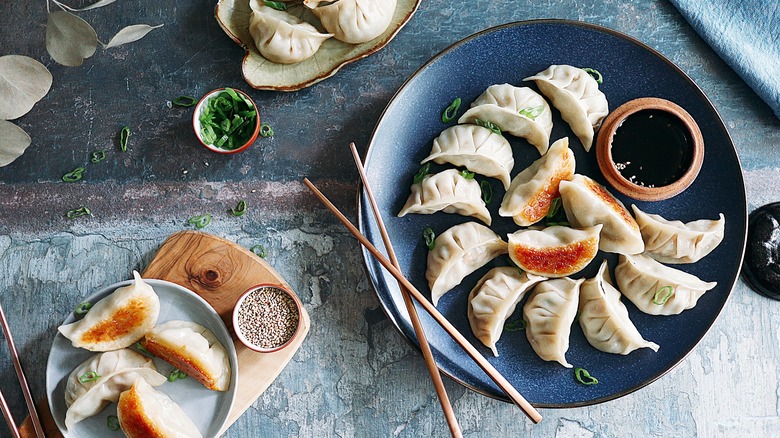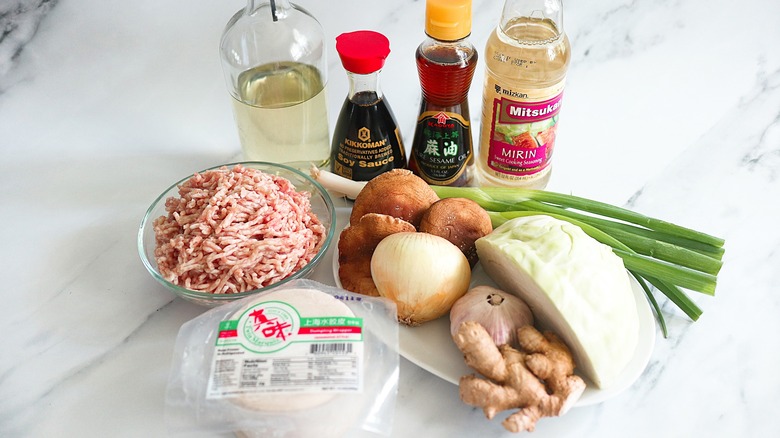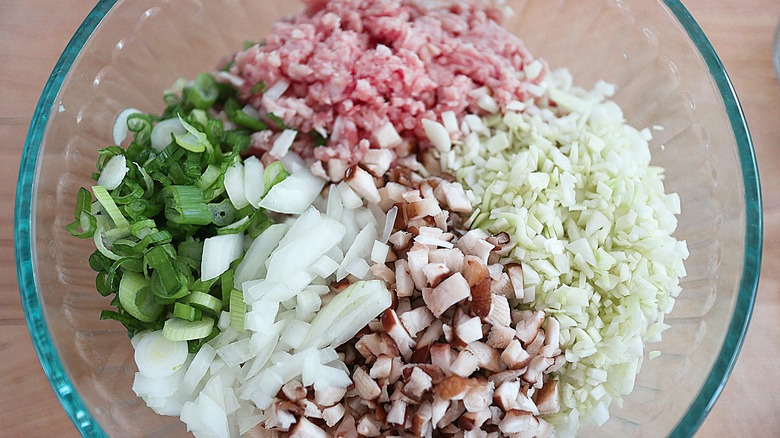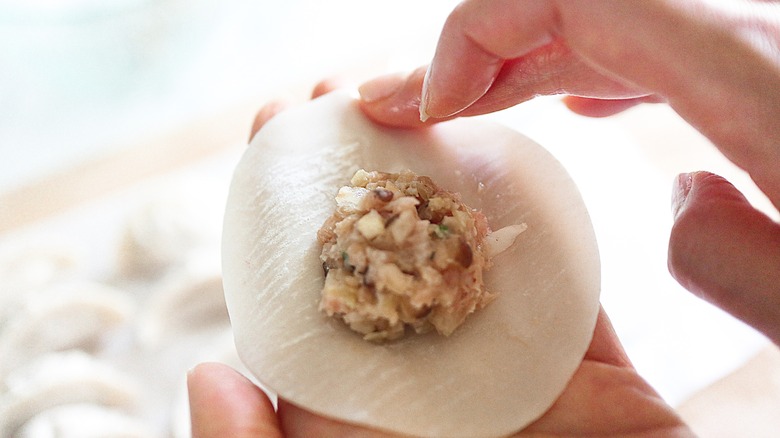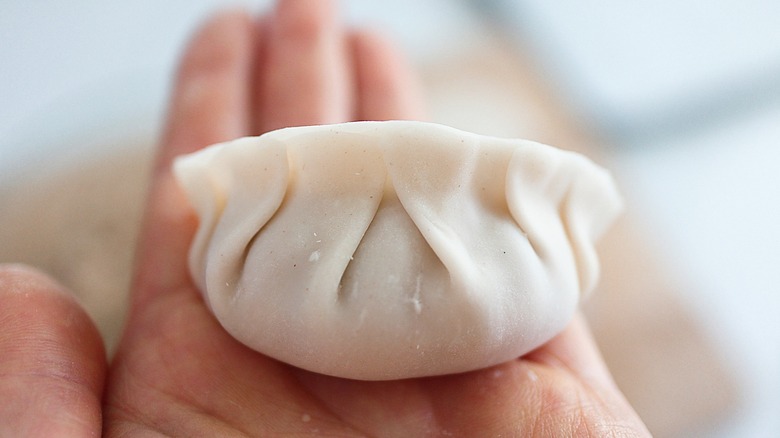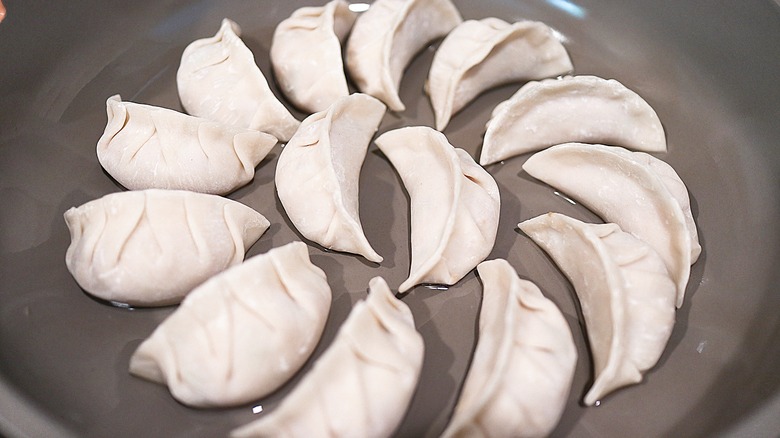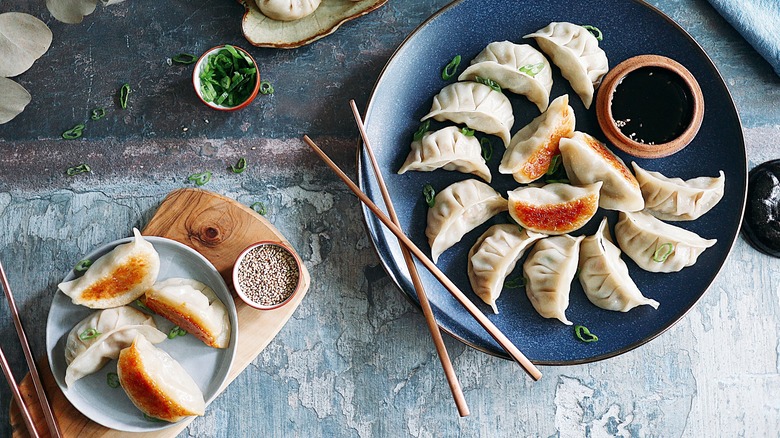Authentic Fried Pork Gyoza Recipe
Gyoza is one of the most famous Japanese appetizers around, and whether you like it steamed or fried, it's always a hit. According to Ejji Ramen, there are a few different takes on just how this delicious dish came to be. Many believe that Chinese practitioner Zhang Zhongjing made gyoza a medicine to treat ears with frostbite. He would cook everything and then place them on people's frostbitten ears to help keep them warm. Now we've heard it all, right? The Chinese people took the recipe and ran with it and soldiers eventually re-created it in Japan.
Recipe developer Cecilia Ryu's take on fried pork gyoza is sure to knock your socks off. She says that her favorite part is "how easy these come together. They do not require a lot of ingredients yet the flavor is amazing," she raves.
If you're looking for a fun thing to make with a group of friends or one to take a stab at yourself, then this recipe surely is for you. Keep scrolling for more details on how to make this delicious and authentic fried pork gyoza in your own home kitchen.
Gather the ingredients
To make these fried pork gyozas, you will naturally enough need to procure some ground pork. You will also need a few vegetables to account for the rest of the filling, namely cabbage, mushrooms, scallions, and onion. As with many Japanese dishes, a few sauces will be added to the mix. Here's that's soy sauce, sesame oil, and mirin. For those who don't know, mirin is a Japanese style of rice wine that's often used in cooking applications.
To complete your list, you need fresh ginger, minced garlic, salt, and black pepper. Finally, of course, you also need at least 40 gyoza wrappers and some canola oil for frying. For some ingredients, like the gyoza wrappers and mirin, you may need to visit a specialty store or grocery focused on Asian foods to procure them if you can't find them in the aisles of your regular store.
Take a few minutes to finely chop the cabbage, mushrooms, scallions, and onion. Mince the garlic and ginger if they haven't come that way already.
Mix the pork gyoza filling
Now that you have all of your ingredients lined up and ready to go, it's time to begin the prep process. Take out a large bowl to mix everything. You need a fairly big one because almost all of the ingredients will go in it and you'll want room to mix everything together without making a mess. Toss your ground pork into the bowl first. Then, add in the cabbage, shiitake mushrooms, scallion, and onions.
Next up are the sauces, including the soy sauce, sesame oil, and mirin. At this time, also add the minced ginger, salt, and black pepper. Mix everything well with a spoon until it's evenly combined. Set aside the mixture, though we'll come back to it in just a minute for the filling stage.
Assemble the pork gyoza
Now that your filling is ready, get a small bowl of water and the gyoza wrappers. Take one gyoza wrapper and place it on the palm of your non-dominant hand. In the meantime, make sure to keep the remaining wrappers covered with a damp towel. This will help to prevent them from drying out and becoming difficult to handle.
Scoop one spoonful of the pork filling and place it into the center of the wrapper. Then, dip your finger of your dominant hand into the water and rub it onto one half of the wrapper edge. Fold the wrapper in half and seal only the top part closed. Working from top to bottom, use your index finger to create three small pleats on one side of the wrapper.
"Putting the gyoza together can be difficult at first," Ryu says. "In my recipe, I suggest making 3 pleats on each side, but you can start with one pleat and work your way up to more once you get the hang of it. They can be intimidating to make, but with a little practice, anyone can make them." Repeat the steps on the other side until there are six pleats. Use the same process with the rest of your wrappers until you run out of the pork filling.
Wrapper troubleshooting
In some cases, you may have trouble getting the wrapper sealed all the way shut. Don't worry, as it happens more often than you think and you are definitely not alone if the wrapper starts giving you any trouble. If this is the case for any of your gyoza, then it likely needs more water to seal properly. Simply rub more water on the edge of the wrapper and continue to seal.
When you finish with the gyoza, place it on a tray and move onto the next one. You'll also want to remember to cover the finished gyoza dumplings with a damp towel or plastic wrap as you're working. This will help them avoid drying out, of course, and will keep them nice and fresh for the frying step coming up next.
Pan fry the gyoza
Take out a large non-stick skillet and heat two tablespoons of olive oil. Turn the heat to medium-high and put the lid over the pan. Add about 12 gyoza in a single later on the skillet, fitting the curves so that you use the space as efficiently as possible. Don't worry, as it doesn't have to look as pretty. You just have to make sure that no pieces overlap. Please note that the oil should not be ultra-hot, not least because you're using a non-stick pan and don't want to use too high of a heat. Cook for about 5 minutes until the bottoms have browned.
Once the bottoms achieve a beautiful golden color, carefully pour ¼ cup of water into the skillet and cover it with a lid. This step will steam the gyoza and finish off the cooking process. Alternatively, Ryu shares that an air fryer should work to cook these, too, should you happen to have one.
Finish cooking and serve
Continue to cook the gyoza until the water has evaporated and the dumplings are cooked all the way through. This should only take about 10 to 15 minutes. If the water evaporates and the gyoza are still not fully cooked, add another 1 to 2 tablespoons of water at a time until they're cooked through.
When the gyoza is done, take them out of the skillet and serve immediately, while they're still hot. As for sauces, you have quite a few options. "You can serve these with your favorite soy dipping sauce or chili oil, but they are great without it too," Ryu suggests. "I actually prefer them plain."
Leftover gyoza can be frozen, too. "Place the assembled gyoza in a single layer on a large tray lined with parchment paper. Make sure there is space in between each gyoza, otherwise they will stick together," Ryu shares. Then, place the tray in a freezer. When the leftover gyoza are fully frozen, put them in a plastic freezer bag. When they're ready to cook, no need to defrost, either. Just throw them into the frying pan and add a bit more cooking time.
Authentic Fried Pork Gyoza Recipe
This take on Japanese fried pork gyoza is sure to knock your socks off. These pan-fried treats are sure to impress and come with a ton of delicious flavor.
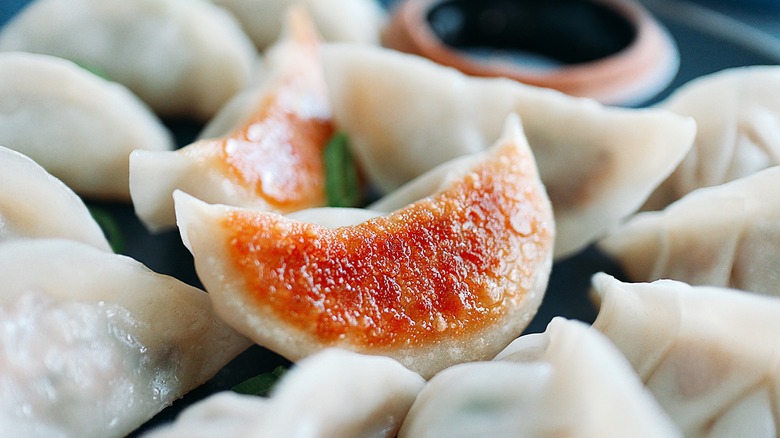
Ingredients
- ¾ cup ground pork
- 1 cup finely chopped cabbage
- ½ cup finely chopped shiitake mushrooms
- ¼ cup finely chopped scallion
- ¼ cup finely chopped onion
- 1 tablespoon soy sauce
- 1 tablespoon sesame oil
- 1 tablespoon mirin
- 1 tablespoon minced garlic
- ½ teaspoon minced fresh ginger
- ½ teaspoon salt
- ½ teaspoon black pepper
- 40 gyoza wrappers
- 2 tablespoons canola oil
Directions
- In a large bowl, combine the pork, cabbage, shiitake mushrooms, scallion, and onions. Add the soy sauce, sesame oil, mirin, garlic, ginger, salt, and black pepper. Mix well until evenly combined.
- To assemble: Prepare a small bowl of water. Take a gyoza wrapper and place it on the palm of your non-dominant hand. Make sure to keep the remaining wonton wrappers covered with a damp towel while assembling to prevent them from drying out.
- Spoon 1 teaspoon of gyoza filling into the center. Dip your finger into the water and rub it onto half of the wrapper. Fold the wrapper in half and seal just the top closed. Working downward from the top, use your index finger to create 3 small pleats to one side of the wrapper. Press and seal each pleat firmly closed. Repeat on the other side of the wrapper until you have 6 pleats total. Place on a tray and repeat until all filling has been used. Cover filled wrappers with a damp towel or plastic wrap while working.
- Heat 2 tablespoons of oil in a large non-stick skillet over medium heat. Add approximately 12 gyoza in a single layer to the skillet. The oil should not be hot. Cook about 5 minutes until the bottoms have browned. Being very careful to avoid splattering oil, pour ¼ cup of water into the skillet and cover with a lid.
- Cook until water has evaporated and gyoza are cooked through, which will take approximately 10 to 15 minutes. If water has evaporated and the gyoza are not fully cooked, add 1 to 2 tablespoons of water at a time until cooked through.
- Serve immediately while still hot.
Nutrition
| Calories per Serving | 773 |
| Total Fat | 16.2 g |
| Saturated Fat | 3.4 g |
| Trans Fat | 0.0 g |
| Cholesterol | 39.4 mg |
| Total Carbohydrates | 126.6 g |
| Dietary Fiber | 4.7 g |
| Total Sugars | 1.0 g |
| Sodium | 1,386.9 mg |
| Protein | 26.4 g |
